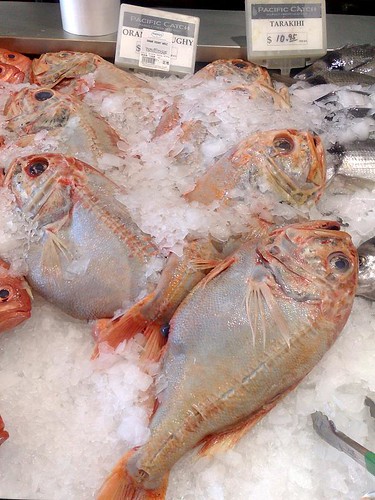Orange Roughy NZ's Whale Equivalent
Thursday, 3 April 2008 by Dr Maytel

It was a damn shame to see that orange roughy was still being sold in New Zealand, almost everywhere we went.
There should be a moratorium on fishing this species. I mean we carry on and on about Japanese whaling yet continue to accept species like orange roughy on our seafood menus....shame on you New Zealand
From the ever reliable wiki
The orange roughy, red roughy, or deep sea perch, Hoplostethus atlanticus, is a relatively large deep-sea fish belonging to the slimehead family (Trachichthyidae). This fish is categorized as vulnerable to exploitation by the Marine Conservation Society. It is found in cold (3 to 9 °C), deep (bathypelagic, 180 to 1,800 m) waters of the western Pacific Ocean, eastern Atlantic (from Iceland to Morocco; and from Walvis Bay, Namibia, to off Durban, South Africa), Indo-Pacific (off New Zealand and Australia), and in the Eastern Pacific off Chile. The orange roughy is notable for its great age — a recorded (disputed by commercial fishers but supported by scientists) maximum of 149 years — and importance to commercial deep trawl fishery. Actually a bright brick red in life, the orange roughy fades to a yellowish orange after death.
Like other slimeheads, the orange roughy is slow-growing and late to mature, resulting in a very low resilience. They are extremely susceptible to overfishing because of this, and many stocks (especially those off New Zealand and Australia, which were first exploited in the late 1970s) have already crashed; recently discovered substitute stocks are rapidly dwindling...In recent years, the consumption of orange roughy has risen drastically due to increased supply through previously impossible deep-sea trawling techniques. Its recovery rate from fishing is slow because of its life cycle and sporadic reproduction making the fish incredibly prone to overfishing. It is the first commercially sought fish to be added to Australia's list of endangered species because of overfishing. According to Seafood Watch, orange roughy is currently on the list of fish that American consumers, who are health and sustainability minded, should avoid. In addition to the dangers for the species, the method of bottom trawling has been heavily criticized by environmentalists for its destructive nature. The destructive nature of bottom trawling combined with the heavy commercial demand has garnered focused criticism from both environmentalists and media.
